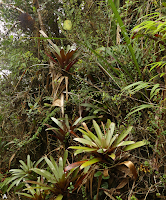 |
| Hyloscirtus sethmacfarlanei Reyes-Puig, Recalde, Recalde, Koch, Guayasamin, Cisneros-Heredia, Jost & Yánez-Muñoz, 2022 Photos: Lou Jost, Fausto Recalde, Juan P. Reyes-Puig. |
Abstract
We have discovered a spectacular new species of frog in the genus Hyloscirtus, belonging to the H. larinopygion species group. The adult female is characterized by a mostly black body with large bright red spots on the dorsal and ventral surface, extremities, and toe pads. The adult male is unknown. Small juveniles are characterized by a yellow body with variable black markings on the flanks; while one larger juvenile displayed irregular orange or yellow marks on a black background color, with light orange or yellow toe pads. Additional distinctive external morphological features such as cloacal ornamentation are described, and some osteological details are imaged and analyzed. The performed phylogeny places the new species as the sister to a clade consisting of ten taxa, all of which are part of the H. larinopygion group. We use genetic distances to fit the new species into a published time-calibrated phylogeny of this group; our analysis based on the published chronology suggests that the divergence of the new species from its known congeners pre-dates the Quaternary period. The new species is currently only known only from Cerro Mayordomo, in Fundación EcoMinga´s Machay Reserve, at 2,900 m in the eastern Andes of Tungurahua province, Ecuador, near the southern edge of Los Llanganates National Park, but its real distribution may be larger.
Hyloscirtus sethmacfarlanei sp. nov.
Proposed standard Spanish name: Rana de torrente de Seth MacFarlane
Proposed standard English name: Seth MacFarlane’s torrent frog
Diagnosis. Hyloscirtus sethmacfarlanei sp. nov. is a member of the Hyloscirtus larinopygion group as diagnosed by Duellman & Hillis (1990), Faivovich et al. (2005) and Weiens et al. (2005), and differs from other members of the group by the following combination of characters: discs of digits narrow; fleshy calcar present cloacal ornamentation with two thick well-defined parallel paracloacal grooves; a well-defined supracloacal fold reaching the vent; skin surrounding cloaca strongly areolate and granular; anterior border of sphenethmoid not in contact with nasal; nasal not in contact with maxilla; frontoparietals rugose; vomers not in medial contact, and with 12‒13 tooth loci; 54‒56 maxillary tooth loci; 10‒11 premaxillary tooth loci; zygomatic ramus of squamosal slightly longer than otic ramus, and otic ramus not in contact with prootic. The adult female, in its reproductive stage with internal sexual characters defined, is further characterized by black ground color covered with large bright red spots on both the dorsal and ventral surfaces, and red tips on all digits.
Distribution: Hyloscirtus sethmacfarlanei sp. nov. is known at the moment only from the type locality in Fundación EcoMinga’s Machay Reserve, Cerro Mayordomo, 2,970 m altitude, in the eastern cordillera of the central Ecuadorian Andes, in the northern side of the upper Rio Pastaza watershed near the southern border of Llanganates National Park in the province of Tungurahua.
Natural history. The type locality consists of dwarf open mossy forest, covered with bryophytes and epiphytes, and saturated with humidity. All four known individuals of this species were found on a single narrow mountain ridge, in bromeliads of the genus Guzmania growing within 60–90 cm above the ground (Fig. 17). The holotype is an adult gravid female with a mass of eggs in early stage of development in March 2018. Adult male, tadpole and advertisement call remain unknown.
Etymology. The specific epithet sethmacfarlanei is a patronym in honor of Seth MacFarlane, American writer, director, producer, actor, artist, musician and conservationist, with an outstanding passion for science, biodiversity and the natural world.
Juan P. Reyes-Puig, Darwin Recalde, Fausto Recalde, Claudia Koch, Juan M. Guayasamin, Diego F. Cisneros-Heredia, Lou Jost and Mario H. Yánez-Muñoz. 2022. A Spectacular New Species of Hyloscirtus (Anura: Hylidae) from the Cordillera de Los Llanganates in the eastern Andes of Ecuador. PeerJ. 10:e14066 DOI: 10.7717/peerj.14066
Zoology Museum at the Pontifical Catholic University of Ecuador (QCAZ)







